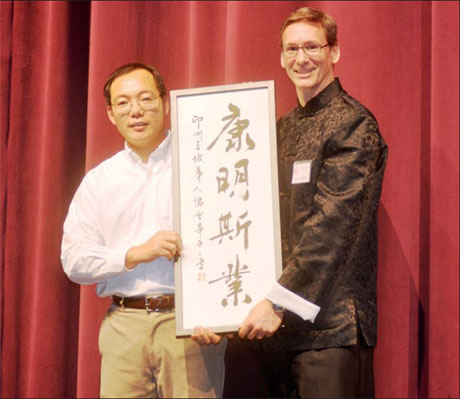US company embraces ties to China
Updated: 2011-12-16 07:42
By Ariel Tung (China Daily)
|
|||||||||
|
Tom Linebarger, president of Cummins, receives calligraphy artwork at the company's Chinese New Year celebration earlier this year. The writing says "A bright future with Cummins." [Provided to China Daily] |
Small-town engine maker in united states fuses Chinese culture with daily work life
Every Thursday for two months, Chen Yang would take a two-hour break from work. It wasn't for lunch, but to teach a Chinese language course to about 30 fellow American colleagues at Cummins Inc, an engine maker located in Columbus, Indiana.
"In the beginning, they could only say ni hao ("how are you" in Mandarin). But now they are able to look at the pinyin and pronounce each word perfectly. That was really rewarding," says Chen, who works as a global emissions compliance analyst at Cummins.
Native-speaking employees, such as Chen, volunteer their services to the Cummins Chinese Affinity Group (CCAG) to teach a series of Chinese language classes, which take place over a six-week period twice a year. The organization, which has about 300 active members, aims to promote and cultivate interest in the Chinese culture at Cummins. A total of 80 non-Chinese employees signed up for the language classes this year.
The course teaches more than pronunciation. It aims to instill an appreciation for Chinese food and tea, and to show participants how to greet a Chinese person when you meet him or her for the first time.
For a long time, Cummins has infused a strong Chinese presence in Columbus. The company, in conjunction with the Columbus Chinese Association, hosts an annual Chinese New Year party for its employees as well as Columbus residents. The mayor of Columbus, Fred Armstrong, attends the event every year.
The Fortune 500 company employs 16,000 people in the United States, most of them in Columbus. Its large presence in China - 9,000 employees - shows its devotion to its business overseas.
China is, after all, Cummins' second-largest market after the US, representing 15-20 percent of the company's business. The company's revenue in China is expected to be $3.8 billion this year and is expected to grow rapidly year-on-year.
"China is becoming a more and more important part of our business. Every week, we have our Chinese customers visiting us in Columbus. Last week, we had a visit from Beiqi Foton Motor, Dongfeng Motor and LiuGong Machinery were here, too," says Edmund Yu, who is the director of international marketing and also head of CCAG at Cummins.
Most of its customers, such as Beiqi Foton, Dongfeng Motor and LiuGong, are engaged in joint ventures with the company. These customers and partners regularly come to Cummins' US headquarters to hold board meetings, to visit the technical center or attend training programs in Columbus.
One of CCAG's tasks, besides organizing Chinese language classes, is to host important Chinese customers and visitors by taking them on tours around Cummins' plant and tech center, recommending Chinese restaurants to them and fulfilling any requests.
Not only is it common for American employees to learn Chinese at Cummins, Chinese expatriates are not an unusual sight at the company.
As part of its training program, Cummins offers Chinese employees the opportunity to work overseas to give them a better sense of the US market as well as global practices.
"When the Chinese employees do conference calls with people in Columbus, they do not know who they are. But after spending three years here, you know everybody. It will be easier next time when you hold a conference call with them. This is a big incentive for the Chinese employees," Yu says.
Yu, originally from Jiangsu province, has worked for Cummins in Beijing, Canada, Mexico and the US.
"I think our Chinese employees feel we are very fortunate to be working for Cummins. We (CCAG) help the Chinese employees here to blend in, to ensure they understand the local culture. We also provide them with information such as how to buy a house and what a 401k is," Yu says.
Cummins' long-standing relationship with China means that the company wants to be looked upon as a local player, not a foreign entity, says Cummins' president and chief operating officer Tom Linebarger. He'll take over as chairman and chief executive officer in January. Tim Solso will retire as Cummins' chairman by the end of this year.
"In the old days, we just brought over US technology. Now the Chinese market is much more sophisticated and has its own emission standards and customers' needs. Over the last five years, we have focused on the Chinese market and to make products just for China," Linebarger says.
The company has been in China longer than most American companies, and even some local Chinese engine manufacturers. Cummins' former chairman, Irwin Miller, first went to China in 1975 in search of business opportunities. Cummins' first China office in Beijing was established four years later.
Throughout the past 30 years, the company has formed 10 long-standing partnerships in China and recently joined with LiuGong Machinery Co Ltd in the Guangxi Zhuang autonomous region. But it was the really the 50-50 joint venture with Dongfeng Motor Corporation in 1986 that paved the way for Cummins' success in China.
Like Cummins' partnership with Dongfeng, most of the company's joint ventures in China are 50-50, which means both parties have equal say in conducting business.
"It was our partnership with Dongfeng that encouraged us to invest more in China. By the 90s, we began to do more joint ventures. We started other businesses, such as our turbo business and filtration joint venture, to support our existing businesses with Dongfeng. We also added two technical centers in Wuhan and Wuxi to build products in China," Linebarger says.
"Our joint ventures remind me of any important relationship - marriage, friendship - where you really are not in charge. It has to be mutually beneficial. That's what drives commitment."
One consistent idea Cummins has been insistent on is getting local talent to run its business in China.
"That's how we want to become successful in China, by unleashing the talent in China to help Cummins. And to help Chinese people better understand Cummins' operations, we get them to come work in Columbus for some time."
Similarly, having American employees knowledgeable about the Chinese market is important to Cummins. The company has sent some of its staff to China to live and work for an extensive period of time.
"If they only work in America, they don't understand how good the opportunity is in China. For us, having employees work in China and come back here, it brings a strong cross-cultural capability," Linebarger says.
The entire Cummins' board of directors has even been to China twice, to celebrate the 25th anniversary of the company's joint venture with Dongfeng and recently to commemorate its new joint venture with LiuGong. They even had traditional Chinese outfits tailor-made for their most recent journey.
Cummins China operates like a local company. Internal staff meetings are often conducted in Mandarin. It's highly unusual for American employees who have worked in China for an extensive period of time to not able to speak the Chinese language, Linebarger says.
"At the celebration of our joint venture with LiuGong, Steve Chapman delivered his speech in Mandarin, and the president of LiuGong translated for him in English," he says.












